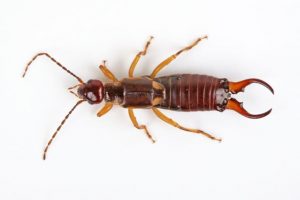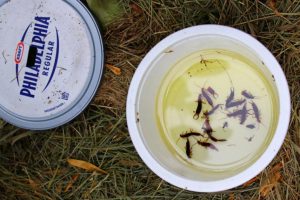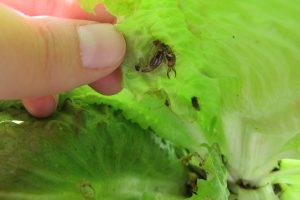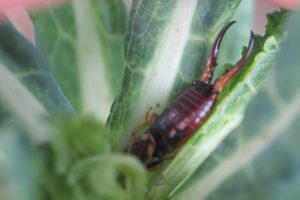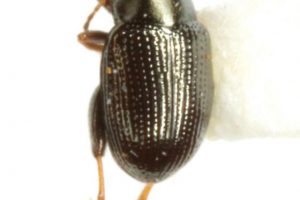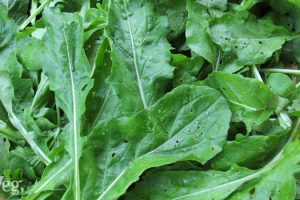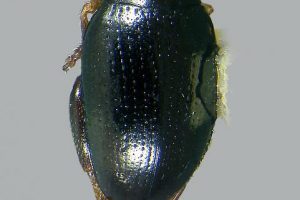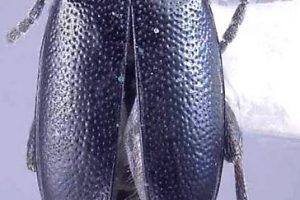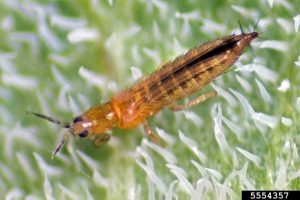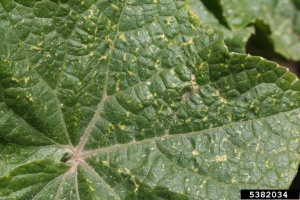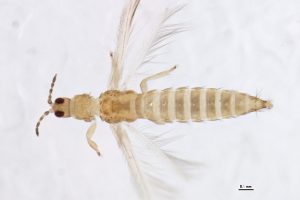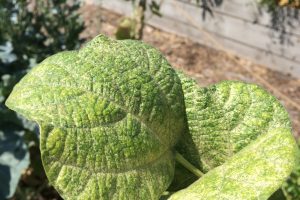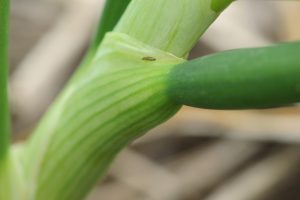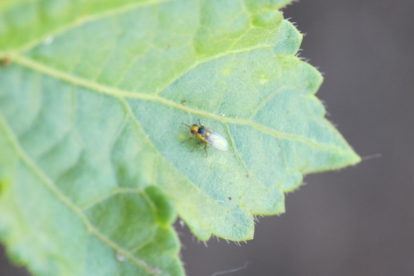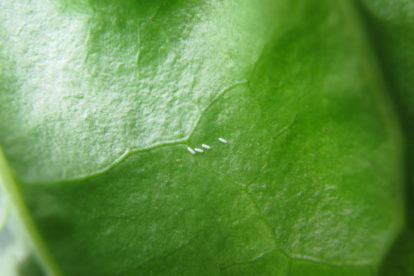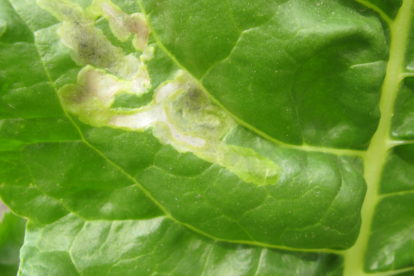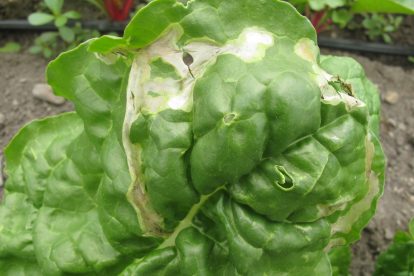In this Issue
- Most Vegetable Crops: Earwigs, Flea Beetles, and Thrips
- Leafy Greens: Leafminers
Watch this video for further information on the pests covered in this advisory along with some others you currently may be seeing:
EARWIGS
European earwigs (Forficula auricularia) can be both beneficial predators and detrimental plant pests. Within vegetable crops, they can cause significant damage and pose a major challenge for home gardeners and farmers.
Adults are slender with a brown body, a red-brown head, and a prominent pair of “pinchers” (cerci) at the rear. Nymphs are similar in appearance to adults but are smaller and lighter in color.
Adults overwinter underground in brooding pairs or above-ground aggregations. In the spring, females lay eggs within nests dug out from the soil. Female earwigs are very protective of their young, cleaning mold off the eggs and providing food for young nymphs. Populations tend to build to their highest densities in mid-to-late summer when the nymphs develop into adults. There are two or more generations per year.
Earwigs are nocturnal and often spend the daytime hiding in dark, tight, and moist places. At night, they emerge to find moisture and feed. Earwigs are omnivores, feeding on a diverse diet that includes plants, fungal spores, small invertebrates, and decaying organic matter. They can be beneficial predators by preying on aphids, caterpillars, mites, and more. However, they can also act as plant pests by feeding on crop foliage and contaminating plants with frass (fecal matter).
Damage symptoms include irregular holes and chewed edges on foliage, buds, flowers, and fruits caused by earwig feeding. Earwigs and their frass can often be found in tight, dark spaces in and around the plants. Earwigs tend to be more abundant in highly irrigated or mulched areas.
- Place boards, corrugated cardboard, rolled-up or crumpled moistened newspaper, or bait containers (e.g., tuna cans, yogurt containers) with smelly oils (e.g., clam oil, bacon grease) in crop areas in early spring and monitor weekly. This can help monitor numbers and mitigate population numbers.
- Since earwigs can be both beneficial and detrimental to crops, only consider insecticidal treatment when there is unacceptable crop damage.
FLEA BEETLES
Flea beetles are a common and significant problem in Utah, particularly in late spring and early summer, affecting numerous vegetable crops and ornamental plants. These small, shiny insects have enlarged hind legs that enable them to jump considerable distances when disturbed. They are also adept fliers, often migrating into crops from nearby fields and weedy borders.
Flea beetle characteristics include elliptical eggs measuring half a millimeter in length. Larvae are worm-like with a white body and brown head. Adults generally range from 1.5 to 4 mm in length and are equipped with large hind legs for jumping. They exhibit a range of colors from brown, green, metallic-blue to black, often adorned with stripes or spots, depending on the species.
Most flea beetle species overwinter as adults in protected locations such as under leaf litter, dirt clods, or on weeds along field borders and ditch banks. These adults become active in mid-to-late spring, initially feeding on weeds and other available plants. As their preferred host plants become available or when weeds dry up, adult flea beetles migrate to nearby fields or vegetable gardens.
After several weeks of feeding, adults of most flea beetle species begin laying eggs in the soil at the base of desirable host plants. The minute, worm-like larvae hatch and start feeding on small roots and root hairs. In some species where development occurs above ground, eggs are laid in clusters on leaves or twigs, and young larvae cause skeletonizing damage similar to other leaf beetles. The larval stage typically lasts about a month, after which they pupate and emerge as the second generation of adults from late spring to mid-summer. Some flea beetle species may even have a third generation.
The high mobility of flea beetles poses a challenge to their management. Understanding their biology and life cycle is crucial for developing effective strategies and timing interventions to mitigate their impact. When managing flea beetles, a comprehensive approach that combines cultural, physical, biological, and chemical methods is recommended:
- Adjust planting times to avoid peak flea beetle activity.
- Promote healthy, fast-growing plants to reduce their vulnerability to flea beetles.
- Utilize trap crops that attract flea beetles away from main crops.
- Employ companion plants that confuse, repel, or physically block flea beetles from finding host plants.
- Remove old plant residue and nearby weeds that can serve as alternative hosts for flea beetles.
- Use row covers to create a physical barrier that prevents pest insects from reaching plants.
- Encourage natural predators such as lacewing larvae, adult big-eyed bugs, and damsel bugs, which feed on adult flea beetles.
Although foliar application of insecticides is frequently used to manage flea beetles, it should be considered only when necessary. This is because plants continuously produce new growth, and the highly mobile nature of flea beetles means they can quickly re-infest plantings. Insecticides may need to be reapplied multiple times to cover the susceptible period of the plant effectively. Therefore, it’s important to monitor flea beetle activity closely and employ other integrated pest management strategies alongside insecticides to minimize their use and maximize effectiveness.
THRIPS
Adult thrips are small, with elongated yellow or yellow-brown bodies and two pairs of fringed (hairy) wings. The larvae are creamy-yellow in color and wingless.
Thrips overwinter as adults in plant debris and protected areas. In spring, they become active and migrate into fields. In Utah, females reproduce asexually through parthenogenesis, individually inserting eggs into leaves. Females continue laying eggs for approximately 3 weeks. Larvae initially remain on the host plant before transitioning to the soil at the plant’s base for a prepupal stage and subsequent pupation. A full generation spans 3 to 4 weeks during the summer, with 5 to 8 generations possible annually. Thrips populations proliferate swiftly in hot, arid conditions, often resulting in significant economic crop losses.
Symptoms of thrips infestation include white flecks or silvery scars on foliage, dark fecal spots on leaves, distorted leaf growth, and reduced bulb size in onions.
When scouting for thrips, use a 10x hand lens. Onion thrips are typically found in the neck of the onion. Look for silvery scars, bleached spots on foliage, and dark fecal spots.
Serious infestations in cabbage can render the crop unmarketable. Tomato spotted wilt virus, vectored by thrips, has the potential to cause fatalities in certain host plants. Iris yellow spot virus, also vectored by onion thrips, can lead to diminished bulb size and quality in allium crops.
To manage thrips effectively, follow these practices:
- Plow under plant debris after harvest and eliminate volunteer host plants.
- Inspect transplants for thrips infestations using a 10x hand lens; discard or manage infested plants appropriately.
- Remove weeds within fields and adjacent to greenhouses.
- Apply mulch to hinder larvae from reaching the soil for pupation.
- Opt for crop varieties that exhibit resistance to thrips.
Thrips have developed resistance rapidly against several classes of insecticides. To achieve optimal effectiveness, insecticides should be used in conjunction with other non-pesticide management practices.
LEAFMINERS
Adult flies are typically small, measuring 1.5-8 mm in length, and vary in color from black to gray, often adorned with yellow markings. Larvae appear pale yellow to white and are devoid of legs. Eggs are oblong and white, typically laid singly or in small clusters.
Pupae overwinter in the soil and emerge as adults early in the season. Eggs are laid on the underside of leaves and hatch within 2-4 days. Newly-hatched larvae tunnel between the upper and lower leaf surfaces, creating irregularly shaped, whitish mines or “blisters.” Larvae eventually exit the mines to pupate on the leaf surface or drop to the ground for pupation in the soil. Leafminers typically have multiple generations per season.
Symptoms of leafminer infestation include white to brown-colored tunnels or mines in foliage, where pale yellow larvae may be found inside. Additionally, affected leaves may show necrotic or dry tissue where the mines have developed.
- Remove weeds and crop debris that can act as alternative hosts.
- Cultivate the soil around crops and late in the fall to uncover overwintering pupae.
- Attract and conserve parasitic wasps that prey on leafminers. Plant flowering plants with nectar and pollen-rich umbel-type flowers.
- Remove infected leaves.
Generally, leafminer numbers are strongly suppressed by natural predators, and outbreaks are usually associated with using insecticides. However, treatment can be considered if populations are high and causing economic damage.
Click Here for More Information on Leafminers

